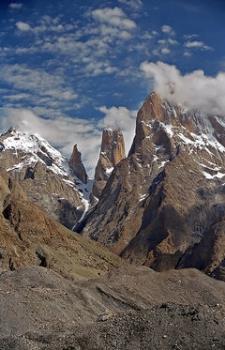geography
By dipzilla
@dipzilla (57)
India
3 responses
@supremegod (1018)
• India
22 Jan 07
its a steep cutting is a mountain or anyother structure. usually cliff is formed when the sea water weathers aways a mountain rock and a steep almost vertical edge is formed and the depth of the water adajacent to the cliff is very high unlike the shore.
@smbilalshah (1316)
• Pakistan
22 Jan 07
In geography, a cliff is a significant vertical, or near vertical, rock exposure. Cliffs are categorized as erosion landforms due to the processes of erosion and weathering that produce them. Cliffs are common on coasts, in mountainous areas, escarpments and along rivers. Cliffs are usually formed by rock that is resistant to erosion and weathering. Sedimentary rocks most likely to form cliffs are sandstone, limestone, chalk, and dolomite. Igneous rocks, such as granite and basalt also often form cliffs.
The Cliffs of Moher in IrelandAn escarpment (or scarp) is a type of cliff, formed by the movement of a geologic fault, or a landslide.
Most cliffs have some form of scree slope at their base. In arid areas or under high cliffs, these are generally exposed jumbles of fallen rock. In areas of higher moisture, a soil slope may obscure the talus.
Many cliffs also feature waterfalls or rock shelters. Sometimes a cliff peters out at the end of a ridge, with tea tables or other types of rock columns remaining.
Given that a cliff need not be exactly vertical, there can be ambiguity about whether a given slope is a cliff or not, and also about how much of a certain slope to count as a cliff. (For example, given a truly vertical rock wall above a very steep slope, one could count only the rock wall, or the combination.) This makes listings of cliffs an inherently uncertain endeavor.
According to some sources, the highest cliff in the world, about 1,340 m high, is the east face of Great Trango in the Karakoram mountains of northern Pakistan. (This uses a fairly stringent notion of cliff, as the 1,340 m figure refers to a nearly vertical headwall; adding in a very steep approach brings the total height to over 1,600 m.) The highest sea cliffs, 1,010 m high, are located at Kalaupapa, Hawaii[1]. (This uses a less stringent definition, as the average slope of these cliffs is about 1.7, corresponding to an angle of 60 degrees.)
Considering a truly vertical drop, Mount Thor on Baffin Island in Arctic Canada is the highest at 1,370 m (4,500 ft) high in total (the top 480 m (1,600 ft) is overhanging). This is said to give it the longest purely vertical drop on Earth at 1,250 m (4,100 ft).
The highest cliff in the solar system may be Verona Rupes, an approximately 20 km (12 mile) high fault scarp on Miranda, a moon of Uranus.
@gormanboy (150)
• Singapore
22 Jan 07
It is a form of relief on the land. A cliff is an area of bare rock which is very steep. Usually found at coasts where coastal erosion has taken it's toll on limestone or chalk rock. Cliffs are made where ever there is erosion undercutting the land.









